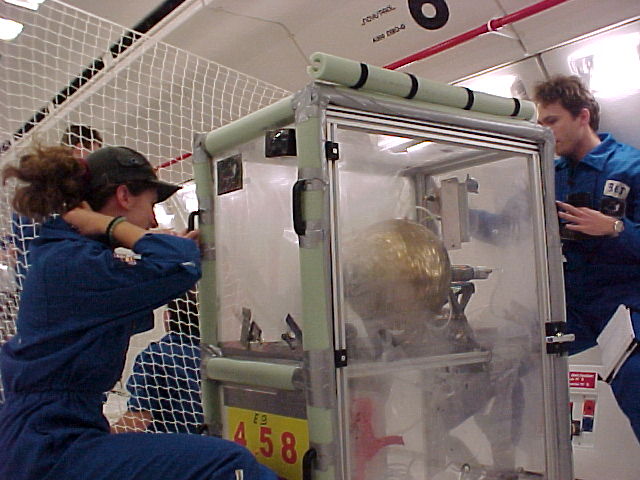|
ISADORA
as a Lounge |
|
Orbit Sweet Orbit An overall impression that the interviews gave me is that artists don't only want to go into space to do art. They want to re-think how we should live in space, or better, rethink the current way astronauts and cosmonauts are already living in space. Artists spoke of "a place to see things grow" or "a place for scientists to get away from their research". The preoccupation is not only with astronaut downtime but with the familiar; giving astronauts homey aspects in orbit. And part of this familiarity is a notion will probably have to involve designing an up and down into the module. Since one of the largest justifications for building the ISS is to study how we will live and work in space 34. ISADORA could also serve as a platform for habitability studies. Anthropologist Fernando Rosa Ribeiro says, "I imagine outer-space as a very inhospitable place. And I think part of being human is feeling somehow at home in an environment. Maybe the ISADORA Module should be the center-piece of feeling at home in space. The other modules are going to be cluttered with scientific equipment. Frankly, I don't know what scientists think, but I don't find that very cozy. It must feel like living inside a laboratory." He adds: "Maybe it's important to take up objects of art or ethnographic objects or objects from the communities or from the homes of the people who are going up. That might also be important. Not only family portraits or mementoes. But things those people are used to..."
"Maybe it's important
to take up objects of art, ethnographic objects or objects
A New Meaning for Haute Cuisine! Alida Neslo adds "I'd like to cook up there. I don't know if that's possible yet but I hope it would be for me. It would be a very important form of expressiveness. That's why I would need some other people around because I like to cook for people." In fact, students from the University of Stuttgart designed a Globular Cooking Facility, an oven in a spherical shape for cooking in microgravity. It was even tested in a parabolic flight campaign with the European Space Agency.35
An oven for Alida. Students from the University of Stuttgart cooking pasta in a parabolic flight.
On occasion space agencies will support programs in academia like the space oven idea. The School of Architecture at the University of Arkansas, for example, conducted joint research with NASA into something called "wearable furniture"; a modular table that is strapped to the waist.36 But unfortunately ideas for more comfortable and spacious modules rarely get into orbit and are simply circulated within the realm of design magazines and the occasional coffee table space habitation book (which this one hopes to become by the way;-). Gezelligheid Another theme is a pre-occupation with astronaut downtime on the part of the artists. Roel-Jan refers to ISADORA as a "room to breathe, to feel free emotionally." He continues, "You have to feel a little bit more free in this module than in different modules". Cinara would expect coziness. "A cozy environment in which you could recollect your internal space. I would expect calm and lots of peace… a place in which ideas can be exchanged with others. But its also very important to have moments of individual research… to be alone in the environment but to also be stimulated by other artists in collaborations." Donald adds: "I would really like a window to look out of or a number of windows to look out of. What I would like is plants. Another kind of living nature other than humans. Like some other kind of animal or plant or other live being other than human beings; house plants; a room that you could go into to see green and watch things grow. Another thing that I personally like is "wasted space", a space that doesn't have a specific intention. A place to pace. So preferably some room with a window. It's just the window room. There's not a function designed to it. You're not supposed to eat there or sleep there or work there. Just a place where you can do whatever you want somehow."
Seeing green
"I would expect it not to be cluttered with scientific equipment. I kind of imagine a space that is somewhat empty, but also cozy. "Gezellig" as they say in Dutch," adds Fernando. "And a kind of space where there would be opportunities or room or furniture even to allow people to interact in a fairly intimate way." The issue of the comfy room came up in the context of rethinking how we will live in space (downtime, not producing art). The comfy or coziness or homey issues did not come up in the context of "I want a comfy studio in which to work". Artists seem to be concerned how we will live in space and not just what we will create in space. Oddly enough there were many references to a cozy, soft place. Jurgen Mueller, creative director of Fura dels Baus suggested a furry place while Rob thought it would be "funny to make it a cozy living room". Soft walls and fabric for ISADORA as a lounge seems to be a common desire in casual conversations I had with people. Did Paco Rabane's furry room for Barbarella really have that much of an impact on visions for space travel?
Barbarella
Email from Paula, Washington, DC OK. Here's my art in space idea for you - A reverse lava lamp. Don't laugh. You, the viewer would walk inside a double-walled tube structure and have the blobs flowing all around you. Personally, I think this would be cool. Unless the chemicals involved posed a "space atmosphere" hazard. I'd like to have a groovy lava wall in my home of the future with colorful blobs of lava goo flowing all around. Also, carved lucite walls, with neon-tube accent colors (to highlight the carvings) would be ultra space agey. Jetsons - eat your hearts out!
The concern with habitability and coziness is very relevant to current and future manned space missions. Astronaut Helen Ochoa at the STAIF 2000 conference in Albuquerque talked about how in the early days of the ISS when the Unity module (which is just a connector module) was the largest space, she said that the crew preferred to hang out in it because it was so spacious. When I asked her what she would have changed in it she said she wished it had more windows so one could have a sense where they were over Earth. So the desire for windows also comes up in the habitation context of space. Astronaut Susan Helms has mentioned wanting more windows to make the station "homier" while astronaut Jim Voss also recognizes the need to feel at home in low earth orbit: "I know that previous expeditions to places like the Arctic have recommended strongly that you provide things like that from home to remind people of scenes of mountains or meadows — things that make you think that you’re at home."37 So at the same time ISADORA is a studio, the module should instil a sense of home. But no matter what the recommendations, it seems like the desires and needs of the artists point to a module that will offer scientists a "gezellig" space to get away from their research or to contemplate it in a different light. Therefore, this idea of home and familiarity that came up in the interviews is a good argument for giving ISADORA a lounge WITH a subjective vertical. This, however, conflicts with giving the Studio having no subjective vertical. What to do? Transformability will need to be the solution if ISADORA is to double as a lounge. These transformations will be shown in T minus 1; A Design for ISADORA. The justifications for the International Space Station have included, since it's conception, being a stepping stone for manned space flights returning to the Moon and to move on to Mars. "The space station is being built," says NASA's administrator Daniel S. Goldin, "to see how people can live and work safely and efficiently in space."38 Research into long duration manned flight has always been on the agenda for the ISS. Furthermore, an ISADORA Module that could double as platform for habitability studies would optimize the full potential of artistic contribution to the expansion of space exploration. Artists clearly would like to contribute to how astronauts could live better in space. Space agencies and industry should seize this opportunity to include artists and designers in the discussion of habitability. |





